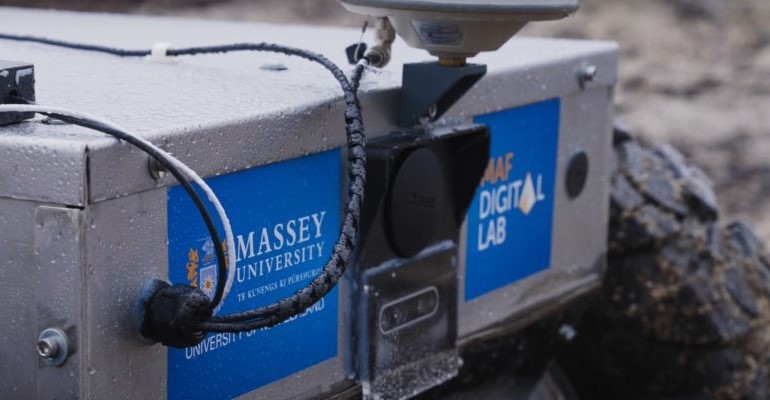28 September 2022 - New robotic tech demonstrated to Taupo foresters and iwi
28 September 2022 | Read time: 8 minutes

A hybrid electric-powered, half-tonne, four-wheel drive, self-navigating robot capable of hauling 250 kgs through gullies, mud and timber slash has been demonstrated to the forestry industry by the SfTI Spearhead project team – Adaptive learning robots to complement the human workforce.
Around the size of a quad bike, the robot has been built from scratch with custom navigational abilities, super strength and agility, as well as a high-tech safety system that uses both thermal and colour cameras to enable it to work safely alongside people. The robot’s huge payload means it has potential uses for tasks like thinning saplings, pruning more profitable trees, as a mule delivering seedlings to planters or for spraying weeds.
The robot uses data from drone overflights as well as machine-learning to plot its own safe paths through commercial silviculture forests. When it detects a forestry worker or other person, using both colour and thermal imagery, the robot stops immediately and replots a new safe path to keep out of the way. Its thermal sensors can detect people even when camouflaged by trees, scrub and other barriers.

The robot is a culmination of several years of collaboration, invention and development from the spearhead team, which was formed in 2017 and received SfTI funding of $5 million. The team includes researchers from Lincoln Agritech, Massey University and Scion with colleagues from Wellington (Victoria), Auckland and Canterbury Universities.

Project Leader Dr Armin Werner is Group Manager – Precision Agriculture at Lincoln Agritech. He says the project has delivered new understandings and tools for outdoor robotics.
“Robots can now better perceive their environment, learn from previous actions and run in challenging terrain while operating safely with people.”
Armin Werner (right) talks robotics with foresters.

Lincoln Agritech’s Dr Jaco Fourie focused on the robot’s machine vision.
“The robot is behaving as it should, so in future research it would be put through rigorous testing in a wide range of conditions before it could be deployed alongside forestry workers.
“We’re looking forward to future iterations of the research and working closely with the industry to make sure we deliver a product that’s exactly what they want.”

In June 2022, the team coordinated a field day and hui to demonstrate the robot’s potential to members of the Lake Taupō and Lake Rotoaira Forest Trusts and local iwi. The Trusts are evaluating the potential of leading-edge technology to enhance their forest and whenua management strategies.

Patrick Nepia Forest Manager for Lake Taupō Forest Management has been involved with the spearhead from its early days and says progress has been very exciting.
“Having technology inside the forests would be a huge step in the right direction for health and safety.”
“Having technology inside the forests would be a huge step in the right direction for health and safety.”

Trustee of the Lake Taupō Forest Trust Ngahere Wall says issues like access in and out of forests, health and safety, plantings, spraying and pruning all have pinch points where technology can help increase efficiency.
“If we can ensure that we’re integrating robots into our current performance and productivity in a way that complements our current workforce . . . we’ll get a lot more involvement from our whanau understanding how robots fit into their picture.”

Research Manager at Lake Taupō Forest Management and Scion forestry management scientist Lania Holt says sustainability and the connection the owners have to the whenua and the forestry business is as important to the Trust as productivity.
“It’s important that the researchers understand the Māori view of forestry and what these forests are going to be like in the future, now that the Crown has exited from this business.”
“It’s important that the researchers understand the Māori view of forestry and what these forests are going to be like in the future, now that the Crown has exited from this business.”

Lake Taupō Forestry Trust and Lake Rotoaira Forest Trust Manager Geoff Thorp says working with the SfTI spearhead is an opportunity to influence what future research will do.
“We see some of the techniques that they’re starting to develop as things that we know we’ll be able to use one way or the other, even if right today, we’re not exactly sure how they might be applied.
“It’s been educational for us to see just how complex some of the challenges are that the researchers face in terms of automation and robotics.”
Successfully delivering technology that works in the field is a huge achievement, but there is much more to do.
"As well a a lot more testing for reliability and consistency, our focus now will be on making sure we deliver something that our industry partners will actually use," Jaco Fourie says.

Thirty-eight percent of Aotearoa / New Zealand's land mass is covered in forest, or which just under 20 percent is managed plantation.